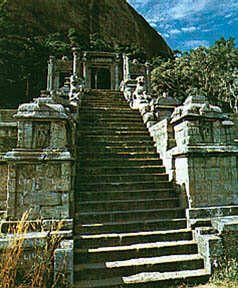
Yapahuwa - once a glorious capital
Take a ten rupee note and have a closer look at it. Does the lion
image in it look familiar to you? That's because, it's the picture of
the famous Chinese-style, stone sculpture of the Yapahuwa lion.

The famous Yapahuwa rock, is situated along the main Kurunegala -
Anuradhapura road, 46 km north of Kurunegala. Its surrounding area was
once the capital of our motherland, for a brief period of time, during
the 13th century. It is said to have been made so during the reign of
King Buvanekabahu I.
There are no references to Yapahuwa in historical documentations,
after the 13th century. According to these sources, Yapahuwa was first
occupied by the Chief named Subha, as a place of defence against the
South Indian forces, who were penetrating southwards into the country.
The rock is believed to have been named after Subha; Subhapabbatha in
Pali and Yapahuwa in Sinhala.
After him, in 1272 Buvanekabahu I had become the King, and moved his
capital from Polonnaruwa to Yapahuwa, taking the sacred Tooth Relic
along with him. He had brought the sacred Tooth Relic from Dambadeniya
and kept it in a specially built structure at Yapahuwa.
However, the Sacred Tooth Relic's enshrinement in Yapahuwa had been
only for a very brief period. Soon after the death of the King in 1284,
the Pandyans of South India had invaded the island, and also captured
the Sacred Relic. The news of this tragic occurrence which had thrown
the Sinhalese into total despair, spread fast through the Buddhist
world.
As soon as the Emperor of China, Kulbi Khar, who had been a great
friend of King Buvanekabahu I, had heard of this devastating news, he
had sent a group of people to India with an offer to exchange the Tooth
Relic for some fabulous treasure. But, it is recorded that before they
could arrive, in India, Parakramabahu III had become the King.
Aware of the fact that his legitimacy to the throne would be in
question as long as the sacred Tooth Relic was not in his possession,
the King had gone in person to meet the Pandyans and negotiate for its
return.
The things that the Pandyans had demanded from the king in return for
the Relic is not known, but the King's mission had been a success and he
had returned with the Sacred Tooth Relic. Then, it had been enshrined
once again in a specially constructed edifice (building) in the new
capital, at Kurunegala.
Architectural features
The walls of Yapahuwa form a rough semicircle, the ends of which join
the foot of the high steeped rock. The outer area consists of an earthen
rampart about 20 feet high and half a mile long, on which a brick wall
once stood. The inner area consists of a stone wall around 12 feet in
height.

It is believed that the houses of the common people would have been
between the outer and inner walls, while the king's palace,
administrative buildings and the Temple of Tooth were within the inner
wall. The magnificent stairway structure goes upwards from the lower
southern slopes of the rock to a natural terrace, where the Temple of
Tooth had once stood. The stairway had originally consisted of three
flights of stone steps.
However, today, the lower one is no more, and has been replaced by
steps of cement. These olden day steps are narrow and need to be
manoeuvred sideways.
According to historians, this may have been done as a form of defence,
as the steps can neither be ascended nor descended, hastily. It would
certainly have paved the way for those at the top to arm themselves
against any enemy onslaught.
At the top of the stairway is a large stone doorway flanked by thick
walls and two exquisitely carved windows. During early excavations one
window had been found in fragments, while the other, called the
Seemeduru Kawuluwa (perforated palace window), had been found in good
condition.
There is a graceful female figure, above which are two wide-eyed
lions and elephants with their trunks extended. When one passes the
door, one can see the remains of the foundation of the temple. The rough
path to the top of the rock is to the left. The caves at the top show
that Yapahuwa was once inhabited by Buddhist monks.
The Chinese connection
There are a number of facts to show that there was a strong
relationship between Yapahuwa and China during the short period it
remained the capital of the island. Excavations carried out by H. C. P.
Bell at Yapahuwa, have revealed Chinese ceramicware and are considered
among the finest ceramics found in the island.

A large number of celedan pottery parts had also been found. In 1949
archaeological excavations carried out in this location unearthed 1310
Chinese coins dating back to the 13th century
Evidence of human settlements
They have also found some strong evidence of pre-historic human
settlements dating back to 1,000 BC to 500 BC (or early 500 BC to 200
AD) in the six acres of flat land surrounding the Yapahuwa rock.
It is believed to be the earliest such settlement found in the
location of a rock capital. Furthermore, the evidence reveals that it
was not a rural settlement, but an urban type of settlement.
This fortress capital, of the Sinhala kings, when abandoned, had been
taken over by Buddhist monks and religious ascetics.
Janani Amarasekara |


